Hardy geraniums care and growing guide – expert tips on how to grow cranesbills
Introduce easygoing hardy geraniums to your planting scheme and their plentiful blooms and lively foliage will add charm to pots, beds and borders
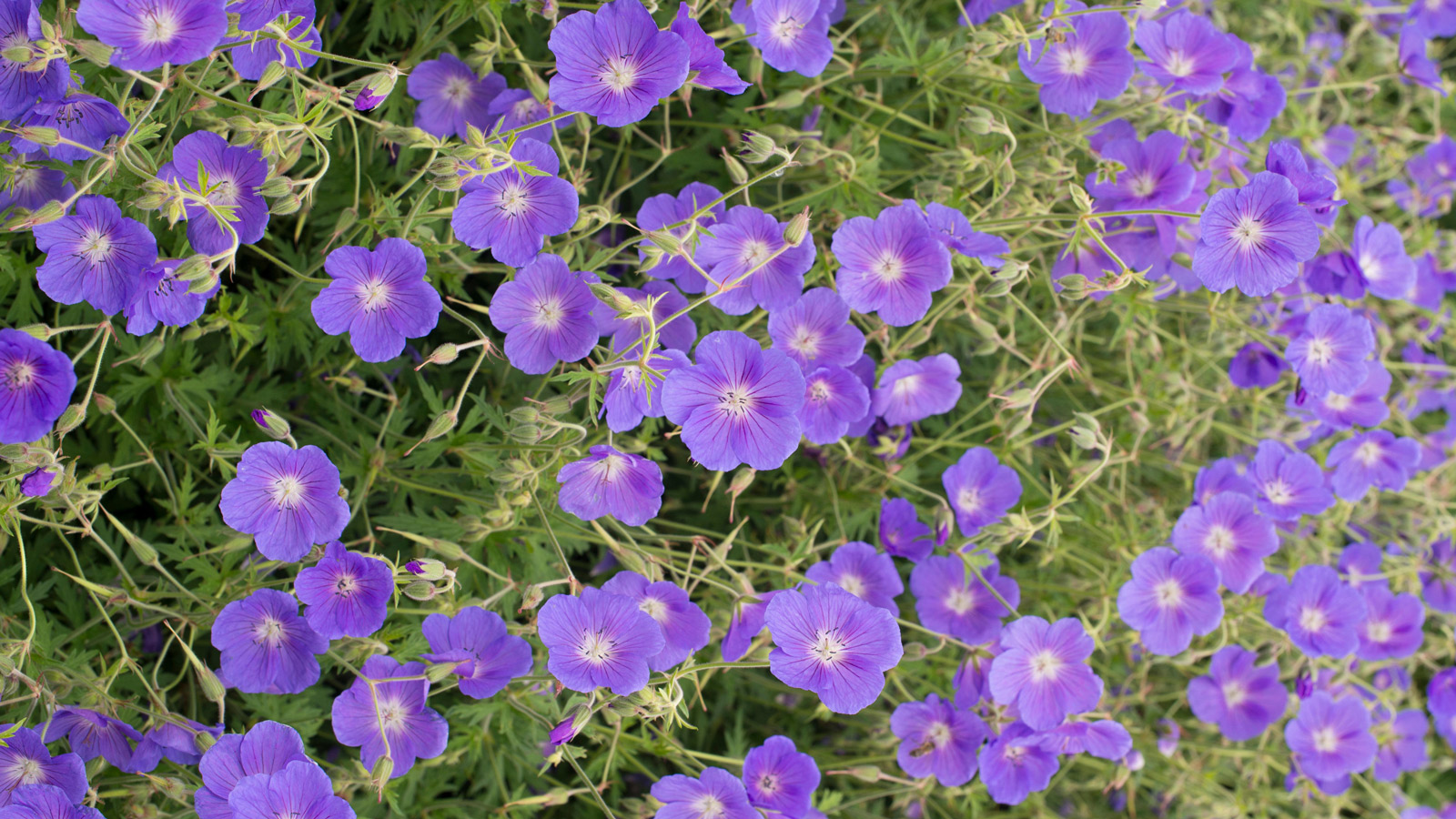
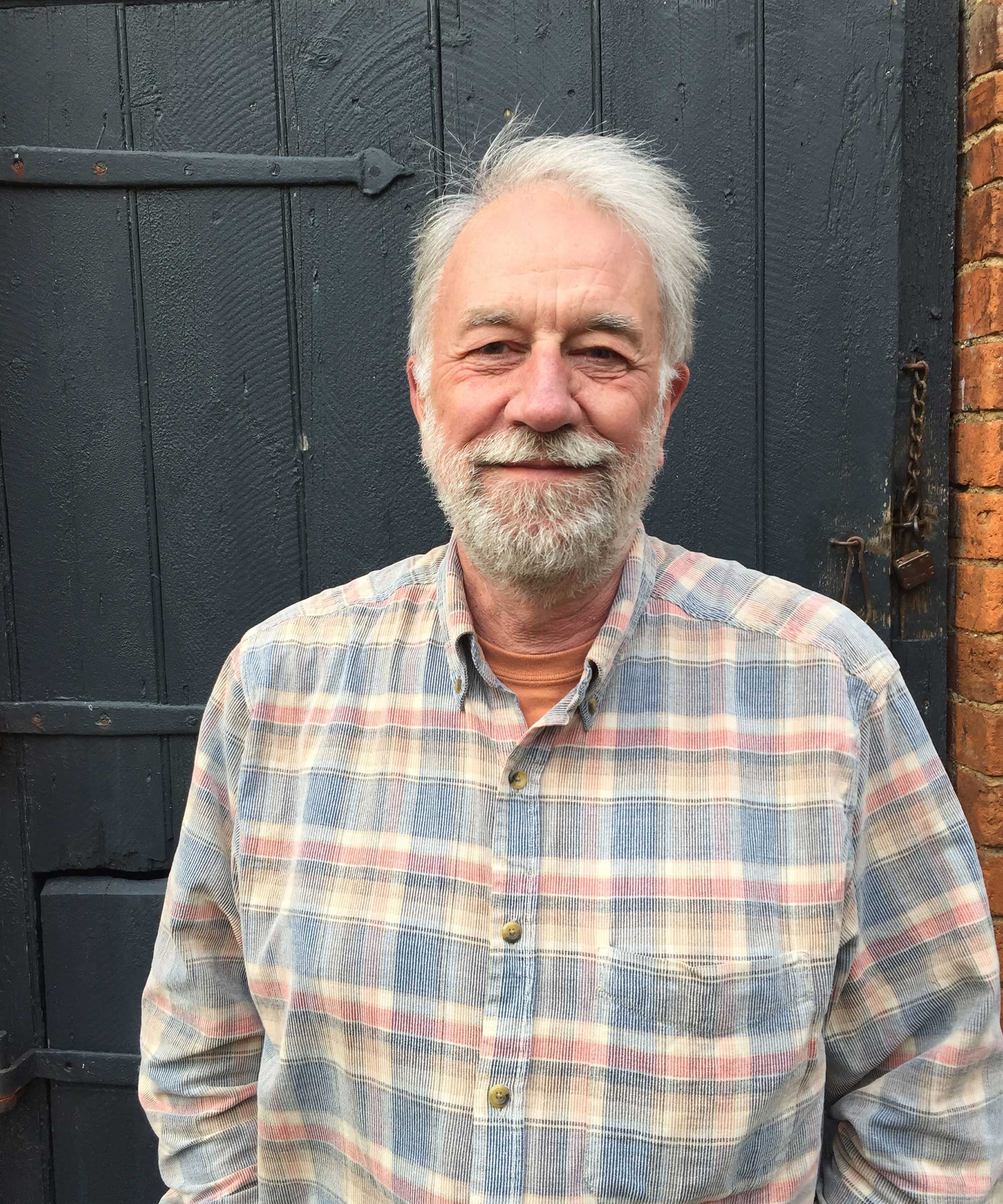
Hardy geraniums (or cranesbills, as they are also known) are some of the most reliable, long-flowering and easygoing perennials you can grow. Most will flower in spring and early summer, but several will continue flowering for longer. These indispensable and easy-to-grow plants have a rootstock that is sometimes tight and woody, sometimes looser and more spreading. With dense mounds of foliage and profuse, delicate floral hues, they are well suited to cottage garden borders, carefree flower beds and well appointed container groupings on a patio or decking.
These perennial plants are called ‘cranesbills’ because the seeds resemble exactly that: a crane’s bill (beak). The terms ‘cranesbill’ and ‘hardy geranium’ are interchangeable, but the fact that they are scientifically referred to as ‘Geranium’ can sometimes cause confusion. This is because ‘geranium’ is also widely used in reference to pelargoniums which are such a feature of containers and summer displays. However, the word ‘hardy’ is your key to spotting the difference, and marks cranesbills as a distinct group with different growing needs.
The leaves and flowering stems of hardy geraniums spring separately from the roots. Their showy flowers have five petals, sometimes notched at the tip and sometimes overlapping. They present in cascading shades of purple, blue, pink and white, often veined in darker shades or featuring a white throat. There are also a few double-flowered varieties with extra petals which ensure that their copious flowering displays last even longer.
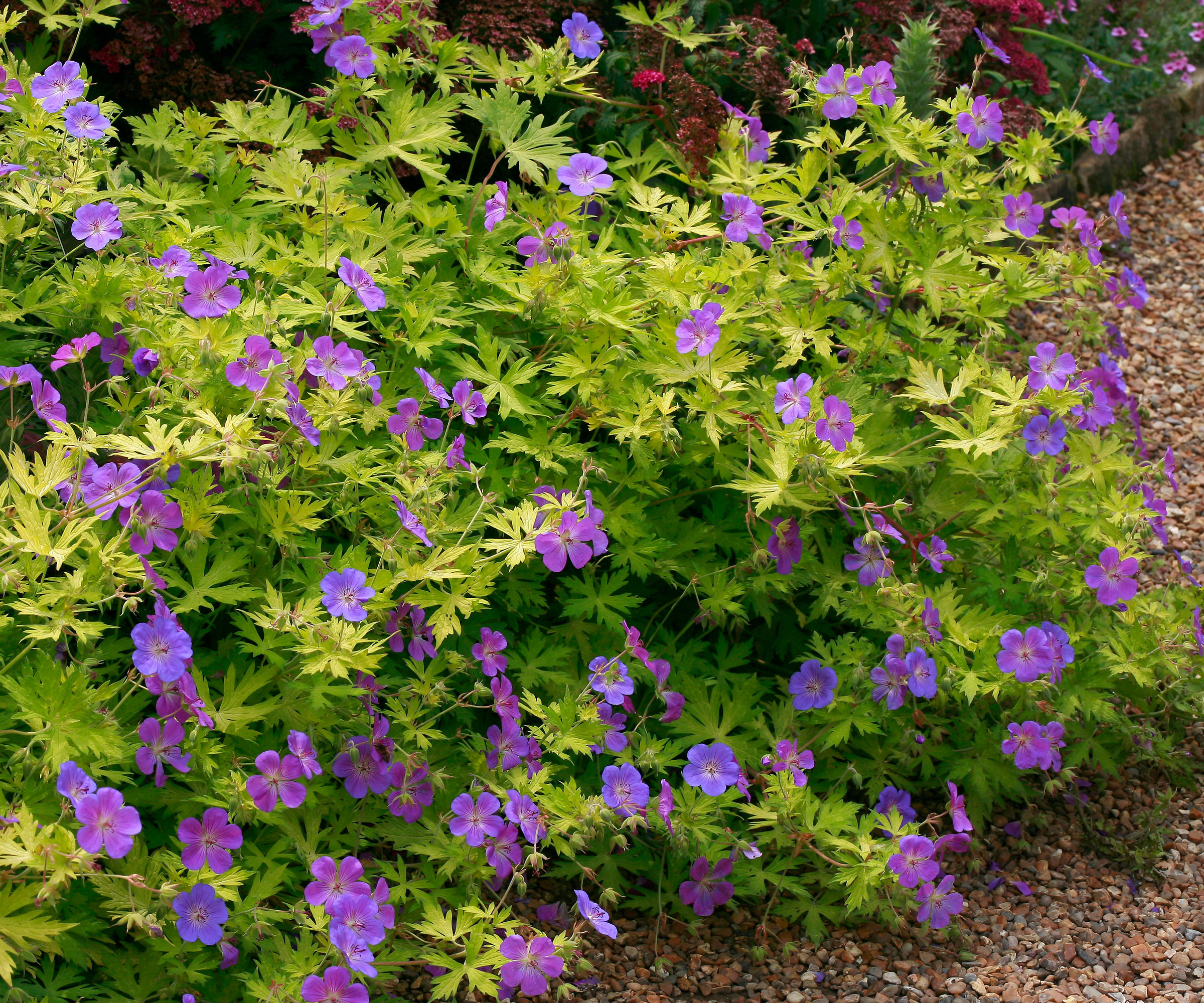
Choose ‘Blue Sunrise’ (‘Blogold’) for reliable and great companions to shrubs and other perennials, with great foliage and flowers

Graham has a wealth of knowledge in all things horticulture. He trained at the prestigious Royal Botanic Gardens in Kew, England, and since then has written more than 20 books on plants and gardening. He gardened in Pennsylvania for 20 years, but has recently returned to his native England.
Hardy geraniums key facts:
- Plant type: Hardy perennials
- Mature size: 6in-3ft
- Soil type: Reasonably fertile and well-drained soils
- Soil PH: Slightly acid, neutral, slightly alkaline
- Time of year to plant: Spring, fall
- Flowering time: Spring, summer, fall
- Flower color: Purples, blues, pinks, white; many veined or bicolored
- Hardiness zones: USDA Z4-9
- Scientific name: Geranium
- Common name: Hardy geranium, cranesbill
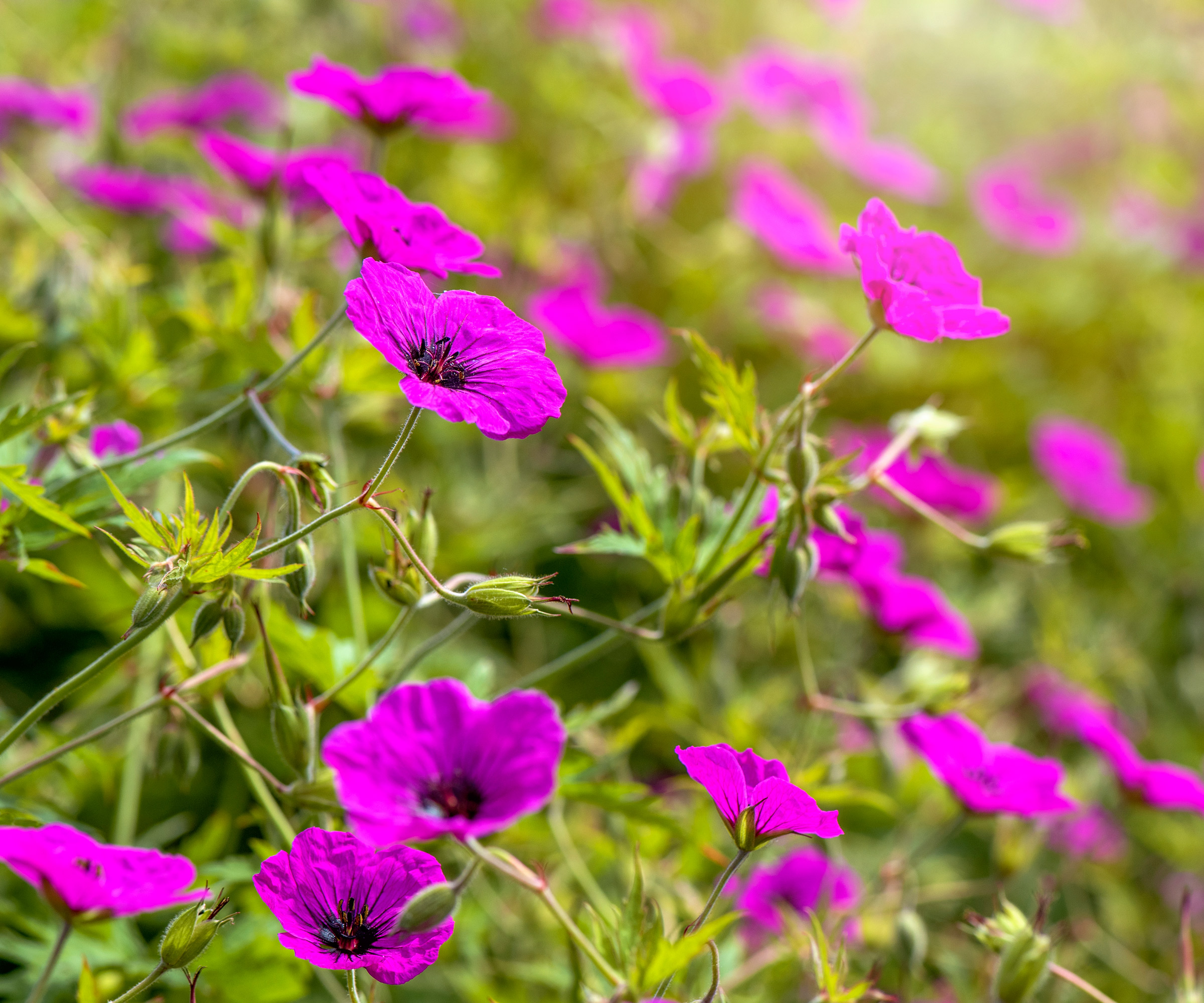
As well as filling borders with purple blooms, you can also get vibrant pink flowerers like ‘Ann Folkard’
Identifying hardy geraniums
For anyone looking to add easy color and foliage to their garden, there is a dizzying number of hardy geranium varieties to choose from. Some are ideal for a low maintenance garden border or pot display, a few add luminosity to a sensory garden, and others make satisfying ground cover options where weed prevention is your primary concern.
The American Horticultural Society describes the cranesbill as 'the most popular of all hardy perennials: invaluable components of bed, border and ground cover plantings in sun or shade.'
There are three main types to choose from:
- Hardy geraniums for foliage Most hardy geraniums have foliage that is quietly attractive, but some make up for a shorter flowering season with a long season of attractive foliage displays. Look for ‘Espresso’ (coffee-colored leaves), ‘Margaret Wilson’ (golden veined leaves) and ‘Samobor’ (dark chocolate blotches). The foliage of Geranium maculatum also colors well in fall.
- Hardy geraniums for flowers Many varieties are identifiable for having showy displays of color. If you are after an unusually long-flowering season of hardy geraniums through late spring and summer into fall, look for varieties such as ‘Ballerina’ (pink flowers, purple veins), available at Monrovia, ‘Orion’ (clouds of blue blooms), Rozanne ‘Gerwat’ (blue, white-eyed), available at Nature Hills, and ‘Tiny Monster’ (magenta, dark veins), available from Monrovia.
- Hardy geraniums for foliage and flowers Some hardy geraniums manage to combine colorful foliage with a long season of flowers. Notable varieties include ‘Ann Folkard’ (with golden foliage and magenta flowers), ‘Midnight Reiter’ (dark purple leaves and blue flowers), and Blue Sunrise [‘Blogold’] (golden foliage, blue flowers).
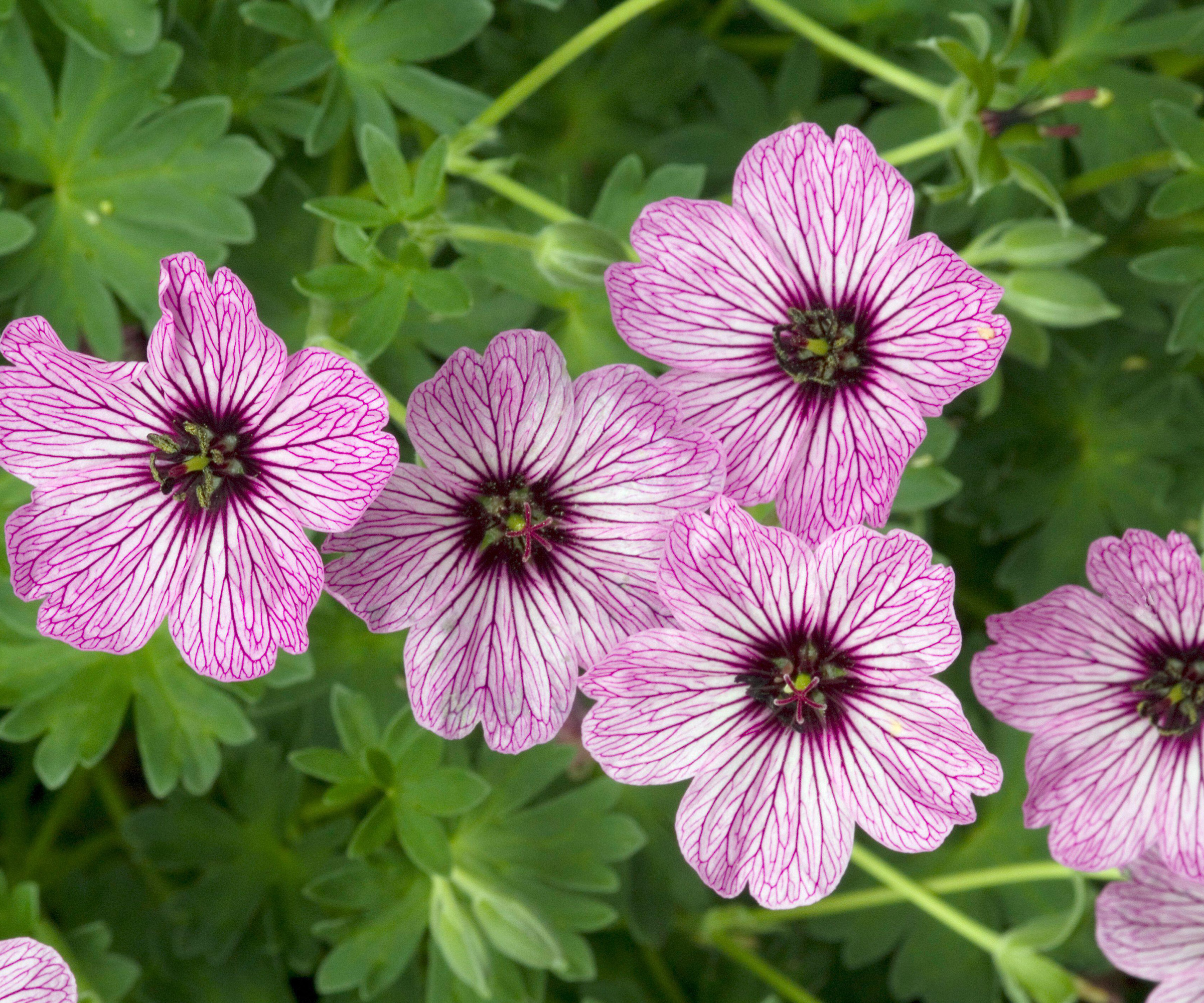
The striking dark-centred flowers of ‘Ballerina’ give a long season of color from late spring into fall
Choosing the right hardy geraniums for your garden
In one sense, you’ll be spoiled for choice if you plan to grow cranesbills. Their easygoing charm and reliability makes them a go-to for all kinds of garden color schemes, themes and styles.
The English founder of modern cottage gardening, Margery Fish, certainly shared this point of view. 'When in doubt,' she wrote, 'plant a geranium.' However, it’s also fair to point out that few hardy geraniums are widely stocked, and a large number have limited availability. So consider where you wish to grow your hardy geraniums, and whether your priority is something more ornamental and striking, or a plant that can work to fill a gap or keep weeds at bay.
- Hardy geraniums for sun Quite a few varieties are unabashed sun-seekers that work primarily in beds and borders and bright patios that receive a lot of direct sunshine. Look for: Havana Blues [‘Noorthava’] (white-eyed blue, magenta veins), available from Monrovia, the so-called ‘Ginormous Geranium’ giant herb-robert (Geranium maderense) with its vast dome of pink flowers, and superb and adaptable Rozanne [‘Gerwat’] (white-eyed, blue flowers).
- Hardy geraniums for shade One of the most agreeable facets to the cranesbill’s nature is that many varieties will thrive in partial shade. If you are looking for the best shade plants possible, then you can’t go far wrong with: ‘Bevan’s Variety’ (magenta pink flowers), ‘Mayflower (‘white-eyed blue blooms) and ‘White-ness’ (white flowers). These varieties will often grow in places that are in shade for more than half the day.
- Hardy geraniums for ground cover Many hardy geraniums make good ground cover but can be too vigorous. However, these particular varieties are excellent options as they will not take over your garden: ‘Biokovo’ (blushed white flowers), available from Monrovia, ‘Dilys’ (magenta pink, purple veins) and ‘Max Frei’ (magenta purple), available from Monrovia.
- Specimen hardy geraniums There are several varieties that make attractive focal displays in a front yard flower bed or container garden. These options, in particular, will make effective specimens in your garden: ‘Mrs Kendall Clark’ (ghostly lavender flowers), Geranium psilostemon (black-eyed magenta blooms) and ‘Purple Ghost’ (white flowers, bronzed leaves).
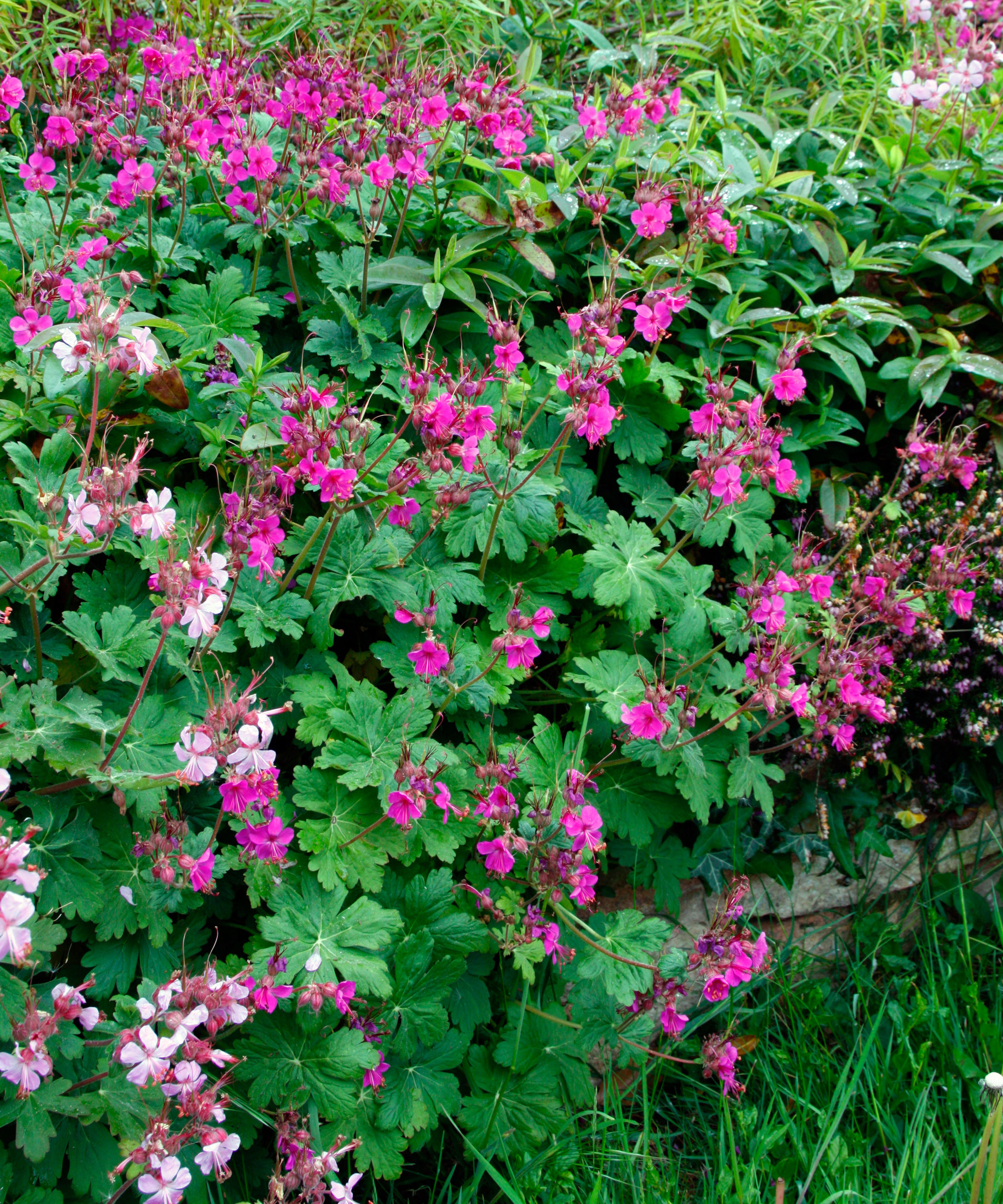
‘Bevan’s Variety’, here with 'Ingwersen’s Variety', produces a splendid cascade of blooms that are tolerant of shade
Where, when and how to plant
For anyone looking to grow cranesbills, one of the most delightful discoveries is how carefree they are when it comes to planting positions, exposure to sunshine and soil types. Few bedding and border plants adapt to such a range of growing conditions with quite this much enthusiasm and vigor. The expert growers at California’s Digging Dog Nursery commend the relaxed temperaments of these plants, saying: 'Their spectrum of colors is rivaled only by their ability to create soft mounds and flowing carpets of lush foliage in ordinary garden soil.'
Hardy geraniums are generally adaptable. While a few are suited to particular planting situations, one of the features that make them such valuable plants is that they are not annoyingly fussy. Most will cheerfully find a home in light shade, although a few of the smaller types prefer to grow in full sunshine. As long as they are not placed in areas that are likely to be scorching, dark, waterlogged or parched, the chances are that your cranesbill will be happy in most conditions.
Best planted in spring or fall, most plants adapt to a range of soil types and can even pop up in paving cracks, such is their hardy nature. That said, they will appreciate amended soil. For individual plants, work some planting mix or well-rotted garden compost or potting mix from last year’s containers into the planting site. It’s a good idea to water plants well with liquid fertilizer immediately after planting. For ground cover, amend the whole area where your hardy geraniums will be planted.
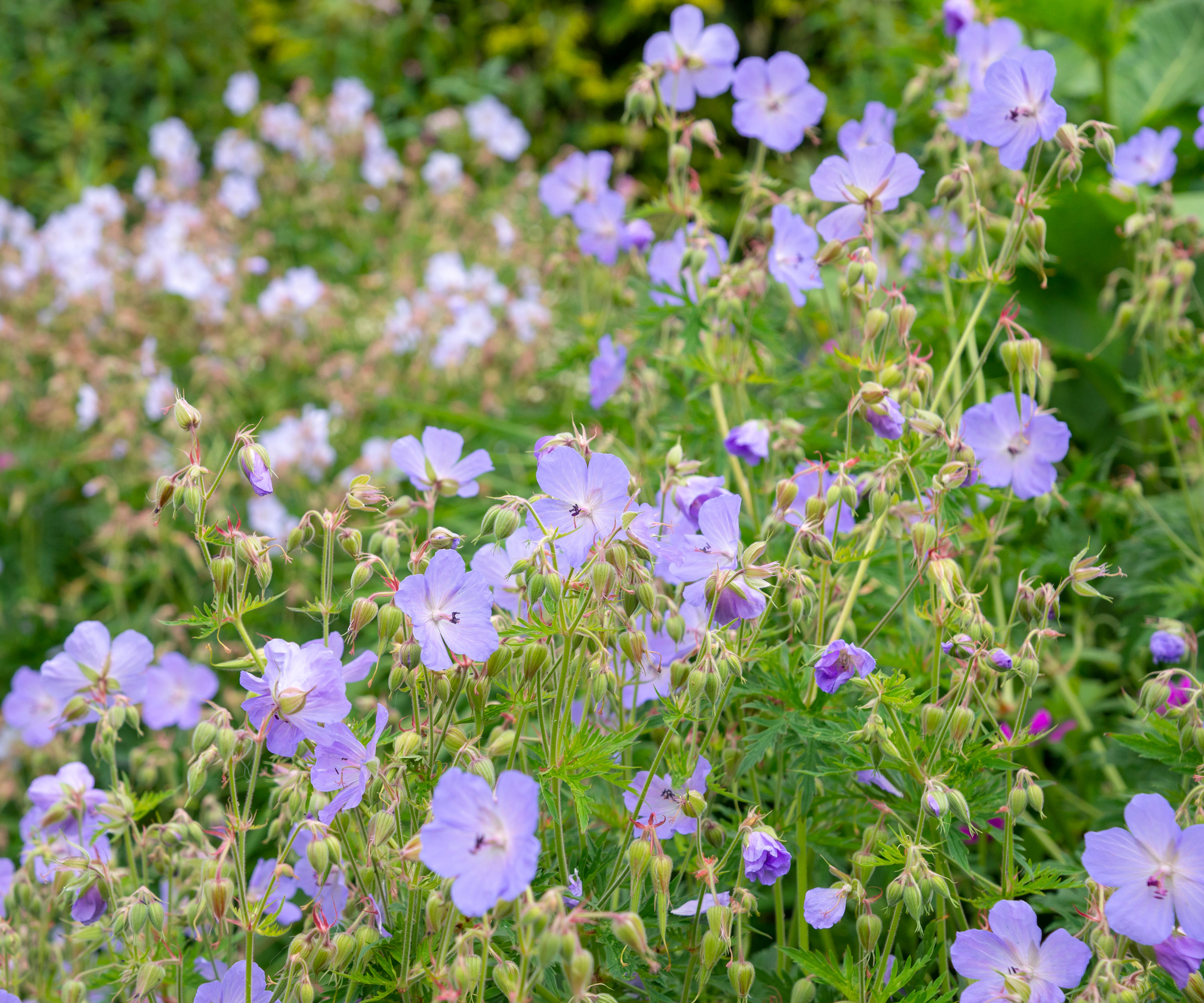
Unfussy cranesbills will be happy in most conditions that are not scorching, waterlogged or dark
Care tips
As the National Gardening Association points out, while these resilient plants give a lot, they require little in return. Maintaining their growth won’t require much in the way of time or techniques. However, these plants do still benefit from a bit of care and attention.
For those with a fondness for vertical garden ideas, several cranesbills work well grown vertically. They just need the right means for keeping them growing upright securely. Taller varieties appreciate thoughtful support, especially those grown in the shade. Wire grow-through supports are ideal, or you can use dry twigs cut the previous winter.
They can be left to their own devices as far as soil checks and moisture levels goes, as long as the soil is well draining. However, a good annual mulching with well-rotted compost, leaf mold or organic matter will help keep plants thriving for a good few years. Most varieties spread slowly but steadily and, after a few years, growth in the center dies out and a ring of shoots remains. In these cases, dig up the whole plant, and replant the healthiest and most vigorous parts.
When flowers die, some hardy geraniums may be too fiddly to deadhead but, if possible, snip out the flower stems at the base to prevent energy being diverted into seeding. Quite often, cutting back after flowering can result in further plant activity. Many plants can be cut back hard in early-mid summer. Cut all growth off to ground level and water well, preferably with liquid feed. You should see a mass of fresh new foliage and, in many varieties, a second crop of flowers.
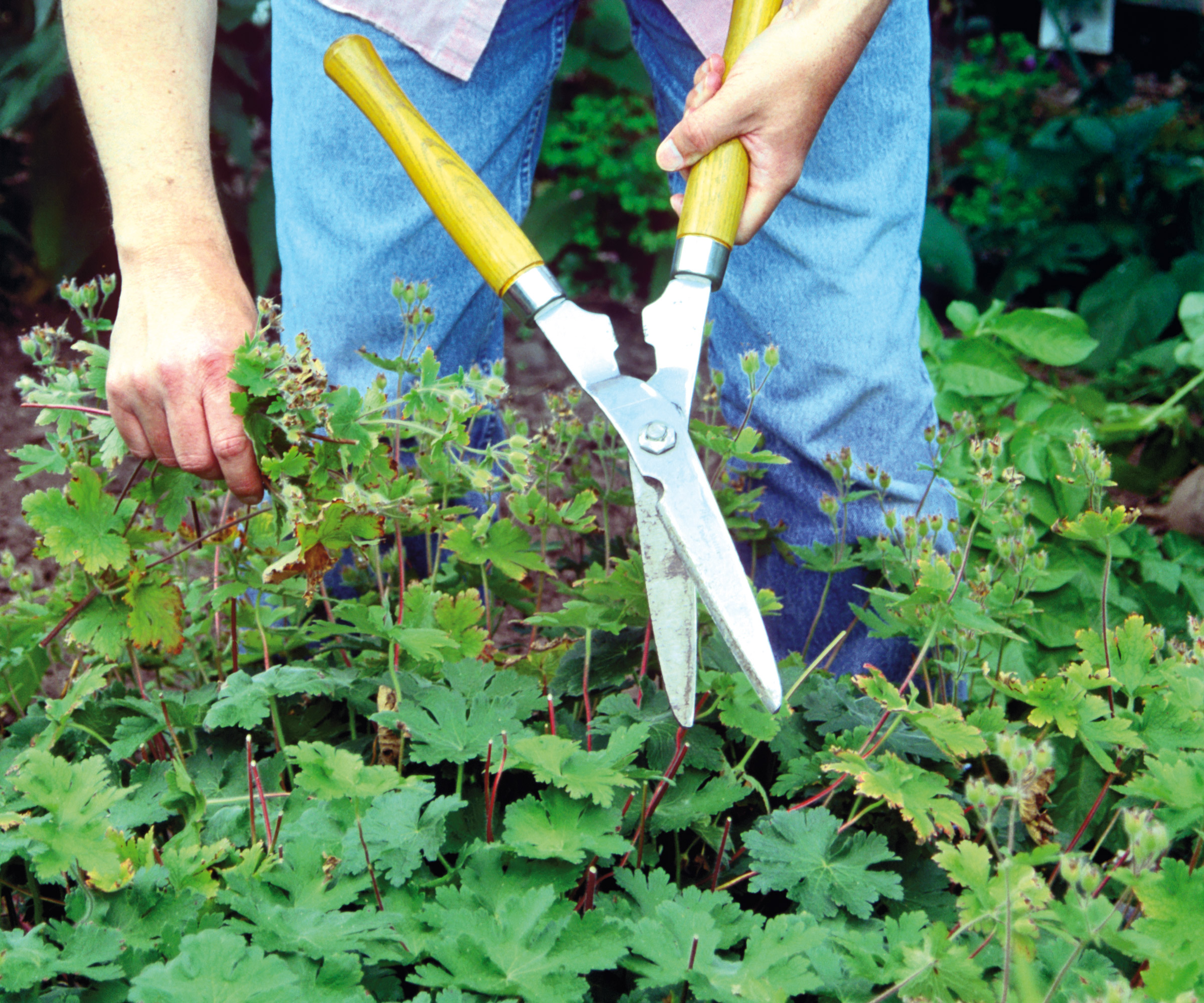
Remove deadheads with shears or remove stems at the base
How to make more hardy geraniums
Hardy geraniums can often grow amongst tiny paving cracks, and this is because of their capacity for self-seeding. Seedlings of several hardy geranium varieties may indeed pop up around your garden if the plants are not efficiently deadheaded. That said, they may differ a little from their parent plants. For many garden plants, plant cuttings would be your best option for making more plants for free – but for these pretty perennials there is another option you can try.
The best approach, which suits most varieties, is to divide your original plants. Knowing how to divide plants is a very straightforward process, and you don’t need lots of experience or special tools. In fact, you just need to follow these three simple steps:
- Dig up your plant in the fall as it is dying down, or in spring as it is starting to grow. Shake off some of the soil from the plant.
- Pull the clump into pieces. If the crown is woody, use a hand fork or pruners to break it into pieces, each with roots and two or three shoots.
- Replant these pieces and water them in. They will soon develop into healthy new plants which will be exactly the same as their parents.

The most vigorous sections of this Armenian cranesbill (Geranium psilostemon) are being replanting with roots and shoots
Key problems and how to solve them
Hardy geraniums are generally reliable plants. If they are kept growing well in conditions they appreciate, problems should be few. Make sure that you take time for regular division, avoid overcrowding, and water in long dry periods, as these steps will all help. Slugs and snails can eat new spring shoots, and aphids and caterpillars may cause problems, but organic remedies are available. Weevil grubs are more difficult to deal with, as they munch through the roots, but they are not widespread.
Fungal diseases including mildew and rust are often caused by plants being too hot and dry or too wet, so keep that in mind when deciding on which varieties to plant, and where. Improve moisture retention in the soil with thoughtful irrigation and mulching to lessen the possibility of infection. Also, make sure that conditions in the ground are well draining to prevent waterlogging or fungal infections from taking hold.

Watch out for cranesbills (like ‘Rozanne’) getting wet as this can leave plants vulnerable to diseases
Growing hardy geraniums in containers
Yes, hardy geraniums make superb plants for containers which you can grow outside as part of your deck or patio planting ideas, especially the large ones. For those considering container gardening, just be sure to place your pot in full sun if you live in an area with cool summers, and in partial or light shade if you are in a warmer area. Never let the plants dry out, feed them every month when the plants are growing, and move them into a larger pot every two or three years. Also be sure to stand the container on pot feet to prevent winter waterlogging.
Varieties to consider are those which are vigorous and long flowering, and which will trail over the side of the pot to create months of billowing color. Those with naturally spreading or bushy growth are ideal. Great varieties to try include: Blue Sunrise ‘Blugold’ (gold foliage and blue flowers), ‘Kelly Anne’ (white-eyed pink flowers), Patricia ‘Brempat’ (magenta with a black eye) and Rozanne ‘Gerwat’ (green foliage with white-eyed blue flowers).

Plant ‘Patricia’ in a pot, and the flowers will keep on coming
FAQs
Why don’t my hardy geraniums have more flowers?
There are two main reasons for hardy geraniums failing to flower prolifically. An extended summer drought may slow growth and reduce flowering, and can also cause the lower leaves on the stems to drop off. Regular irrigation in dry periods is the answer here.
There is another possibility. Sun-loving varieties will flower poorly in constant shade, especially overhead shade from trees. It may be that when your hardy geraniums were planted, they were in good light, but that nearby trees have expanded their growth. Of course, they may have been planted in the wrong place to begin with. Certain cranesbill plantings work best with south-facing garden ideas or sunny container spots, so bear this in mind. Depending on the cranesbill variety you are trying to grow, some are likely to flower well with plentiful sunshine.
Are hardy geraniums deer resistant?
If you are looking for the best deer-resistant plants, there’s some good news. However, if this feature is important to you, then you do need to be careful about the selections you choose. Basically, cranesbill varieties vary in how resistant they are to deer browsing. If you are looking for plants that have full deer resistance, opt for the strongly aromatic foliage of ‘Bevan’s Variety’ (magenta pink) and ‘White-ness’ (white), as both of these discourage deer so they very rarely attempt to eat it.
Other varieties, such as ‘Biokovo’ (blushed white) and ‘Max Frei’ (magenta pink), are less resistant. At the other end of the scale, varieties like ‘AT Johnson’ (silvery pink) and ‘Walter’s Gift’ (pink, lavender veins) are quite popular with deer. Certain widely grown hardy geraniums vary in how resistant they are to deer – so it pays to check individual varieties with the nursery before you buy.
Are hardy geraniums invasive?
In general, cranesbills are not invasive plants – but there is an exception. In the west, from British Columbia south to north California, there is an annual type called shiny geranium (G. lucidum) which has become a serious problem.
Shiny geranium is native to Europe, Asia and north Africa, and has escaped from gardens into the wild. This is odd as it is less colorful than most, and makes less of a show, so it has rarely been grown as an ornamental: it is more of a weed. Since there are so many better varieties to grow, you will be missing nothing by not planting this one.
Several hardy geraniums are North American native wildflowers, but most are not. Furthermore, a few are irritating garden weeds, so take care. The most familiar of the two dozen North American native species is the spotted geranium (G. maculatum). It gets its name from the dark spots on its leaves. Found across the east, midwest and south, this is a pretty woodland flower, often now seen growing along highways.
Where to buy hardy geraniums
There are many, many hundreds of different hardy geranium varieties, so if you have a particular theme or spot in mind, it’s worth reading up on the selections you have in mind before buying. Garden centers and the garden areas of DIY stores will usually offer a few varieties, but these may be chosen for how quickly the nursery can grow a saleable plant, rather than the performance of the plant after you have planted it at home.
This, in particular, is where it pays to shop at a specialist mail order nursery. The grower will focus on the quality of the variety as it develops in your yard. Several mail order nurseries have a selection tool on their website which enables you to choose your hardy geraniums by flower or foliage color, height, vigor, and more. All the varieties mentioned above are excellent entry points for beginners. Use our quick links to find cranesbill varieties for both bright and shady spots, ground cover, bedding displays, container gardening and specimen planting.
Sign up to the Homes & Gardens newsletter
Design expertise in your inbox – from inspiring decorating ideas and beautiful celebrity homes to practical gardening advice and shopping round-ups.

Graham Rice is a garden writer who has won awards for his work online, and in books and magazines, on both sides of the Atlantic. He is a member of a number of Royal Horticultural Society committees and the recipient of the 2021 Garden Media Guild Lifetime Achievement Award. He gardened in Pennsylvania for 20 years, but has recently returned to his native England.
-
 Miley Cyrus breaks a cardinal decorating rule with her 'floating table' – her unexpected layout transforms a dead space into a stylish breakfast area
Miley Cyrus breaks a cardinal decorating rule with her 'floating table' – her unexpected layout transforms a dead space into a stylish breakfast areaThe singer tosses aside the maxim that furniture shouldn't be floating in the middle of the room with an innovative kitchen layout
By Sophie Edwards Published
-
 It’s a concept straight out of a fashionista's playbook, but I used the Sandwich Method to organize my kitchen shelves – it’s never looked sleeker
It’s a concept straight out of a fashionista's playbook, but I used the Sandwich Method to organize my kitchen shelves – it’s never looked sleekerIt transformed messy to mesmerizing in a matter of seconds
By Punteha van Terheyden Published